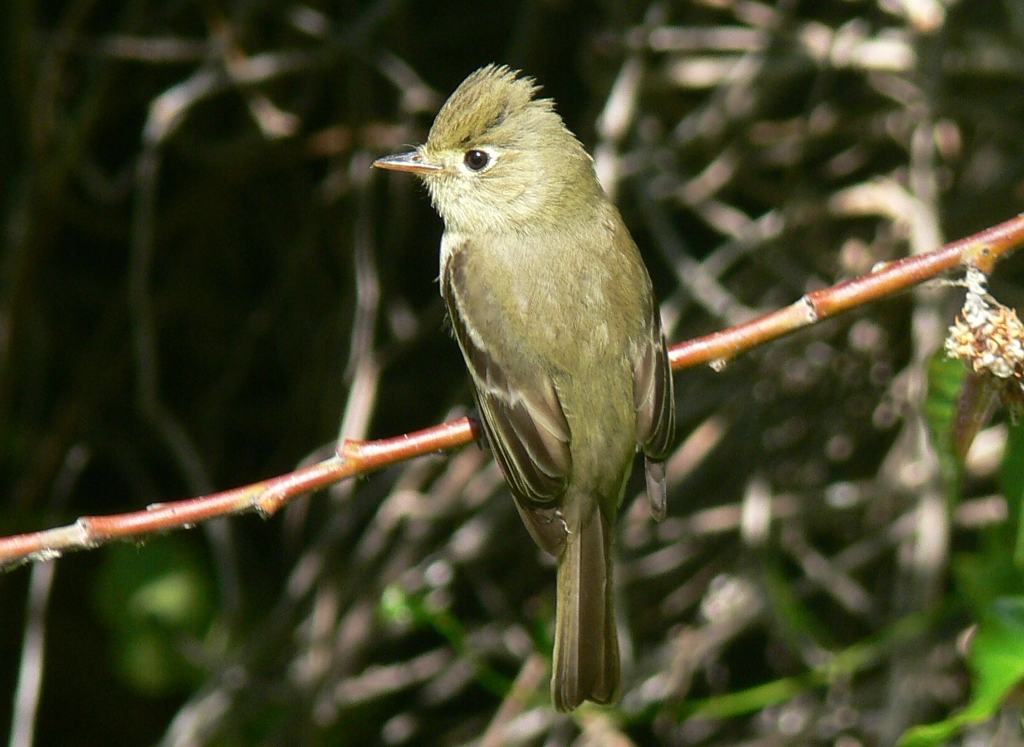
Scientific Name
Empidonax difficilis insulicola
Introduction
A small yellowish flycatcher of shaded forests and streamsides, the Pacific-slope flycatcher is found throughout the Pacific Coast states, west of the Sierra Nevada and Cascade mountain ranges. The population of Pacific slope flycatcher breeding on the Channel Islands off southern California may actually be best treated as a distinct subspecies. It is larger than mainland populations, has a longer bill, a paler chest, slightly different vocalizations, and differs genetically.
Quick and Cool Facts
- The New World family of flycatchers, Tyrannidae, includes the Pacific-slope flycatcher is p, and 365 other species distributed over the Americas from the Canadian tree limit to Patagonia.
- The name tyrannidae, meaning tyrant, reflects the species pugnacity toward crows, hawks, and other large birds which they harass with great determination.
- The scientific name difficilis, which in the Latin is appropriate as it means "difficult ". This species is extremely difficult to distinguish from the similar Cordilleran flycatcher.
- These two above species were formerly considered a single species known as the western flycatcher.
- Flycatchers characteristically feed by darting after insects from an advantageous perch.
- A group of flycatchers has many collective nouns, including an "outfield", "swatting", "zapper", and "zipper" of flycatchers.
Appearance
Pacific-slope flycatchers on the Channel Islands are larger than individuals of mainland population. The species in the park also has a longer bill, a paler chest, slightly different vocalizations, and differs genetically.1 The Pacific slope flycatcher, Empidonax difficilis, found on the mainland has olive-brown upper parts, yellow throat and belly; and an olive-gray breast. Eye-ring is white and elongated. Its wings are dark with two pale bars. Bill is long with dark upper mandible and bright yellow lower mandible. Sexes are similar.
Range
The island subspecies is considered a summer resident on Santa Rosa, Santa Cruz, and Anacapa. Nests have been on the north facing slopes of West Anacapa. Middle and East Anacapa do not have the trees for their preferred nesting habitat. (Collins personal communication 2010) Pacific-slope flycatchers are spring and fall transients on the other two park islands (Jones, Collins, and Stefani 1999). While there are occasionally spring and fall transients of other Empidonax Flycatchers, the most common of these flycatchers is the Pacific-slope flycatcher. Transient sightings of other species of Empidonax Flycatchers are more common on Santa Barbara Island than on the northern park islands (Jones, Collins and Stefani 1999). These flycatchers migrate for the winter, probably to Mexico. Since the different Empidonax Flycatchers look so similar in the field, exact information about this subspecies's winter location is not available.
Habitat
The Pacific-slope Flycatcher inhabits either coniferous or deciduous forests. In its range it enters mixed woods, douglas fir forests, redwood forests, and many other wooded environments including Riparian woodlands. A recent study found Pacific-slope flycatchers on Santa Rosa to prefer pine, chaparral, woodland and riparian habitats.
Feeding
Like most flycatchers, Pacific-slope flycatchers are insect eaters and they can be seen watching from a perch, at any level within shady parts of the forest, and then flying out to catch insects in the air. Individuals also capture some prey (such as caterpillars and spiders) from foliage or twigs while hovering.
Reproduction
Nesting habitat in more open and drier habitats on Channel Islands for the distinct island flycatcher occurs among eucalyptus shade trees or in oak clumps in canyon bottoms, foraging over coastal scrub and opuntia cactus (Johnson 1980). Nests are placed on cliffs, earth banks, tree branch crotches, or building ledges, or in tree cavities, often along streams or near seeps or springs.
Pacific-slope flycatchers breed once annually from mid-April through mid-July. On the average four eggs are laid per season with hatching occuring from 13 to 16 days. The female alone incubates the eggs but both sexes bring food to the fledgling young and remove fecal sacs. Typically, chicks will fledge within 14 to 16 days.
Conservation Status
While long term population trends have not been quantified, Pacific-slope flycatchers are a species of Least Concern according to the IUCN Redlist. They are not listed under the U.S. Endangered Species act or the Convention on International Trade in Endangered Species. They are listed and protected under the U.S. Migratory Bird Treaty Act. Pacific-slope flycatchers on Santa Rosa were found to exist at high densities over a 15-year period, with some annual variation in abundance. 8 Breeding Bird Survey data show no significant declines of this species between 1966 and 1996.
Additional Information
- http://www.allaboutbirds.org/guide/Pacific-slope_Flycatcher/lifehistory
- http://identify.whatbird.com/obj/171/overview/Pacific-slope_Flycatcher.aspx
- http://ibc.lynxeds.com/ssp/pacific-slope-flycatcher-empidonax-difficilis-insulicola
- http://www.encyclopedia.com/topic/flycatcher.aspx
- http://www.planetofbirds.com/passeriformes-tyrannidae-pacific-slope-flycatcher-empidonax-difficilis
- http://eol.org/pages/917414/details
- Coonan, T. J., R. C. Klinger and L. C. Dye. 2011. Trends in landbird abundance at Channel Islands National Park, 1993-2009. National Park Service, Natural Resource Stewardship and Science. Fort Collins, Colorado. Natural Resource Technical Report. NPS/CHIS/NRTR-2011/507. Published Report-2180888.
Is there something we missed for this itinerary?
Itineraries across USA


















































